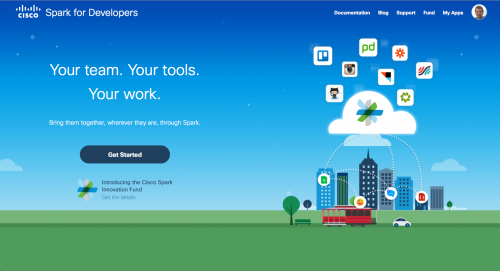
In this new age of business digitisation, with change and innovation increasing at a rapid pace, allowing people to collaborate seamlessly is critical to success. This is no longer about providing applications for specific workloads, but connecting these applications together to automate processes and embedding Collaboration capability into business applications. This is where the worlds of Collaboration and IoT (Internet of Things) come together, and having a rich set of easy to program APIs to enable these integrations is fundamental.
Cisco is providing these APIs across all of its Collaboration portfolio, but in particular in its Spark and Tropo cloud platforms that have been built from the ground up on APIs.
Spark brings together the three key types of communications tools that people use – messaging, meeting and calling – into a single experience. Everything Spark does is enacted through APIs, and some of these APIs have been exposed for developers and end users to leverage, with more to come. There are three ways in which Spark’s APIs can be accessed.
Firstly, there are several, native integrations that can be easily configured in the Spark app, including Github, Trello, Zendesk, Pagerduty and Instagram.
Secondly, Spark is supported by the application integration services Built.io, Zapier and IFTTT, which allow users to connect to other applications with a few clicks. An example of a very easy integration that could be set up using these application integration services would be to post a message and link in a Spark room for a project if a row is updated in Smartsheet. This means people can continue to use whichever applications they like for specific functions, with Spark becoming the Collaboration hub through which they connect to these other applications.
Finally, Spark for Developers allows custom integrations to be created using Spark’s REST APIs. These APIs were built by the Tropo team to be easy to use. The Spark for Developers portal provides API reference documentation, tutorials, SDKs and 24/7 support for developers.
Tropo is a cloud Collaboration Platform as a Service (PaaS) that was acquired by Cisco in 2015. It provides communication capabilities in the cloud that can be embedded into business applications through APIs. Some of the key features available with Tropo are global phone numbers, transcription, call recording, conferencing, text to speech and speech recognition. Tropo has a 200,000+ developer network which has been attracted by the easy to use APIs and the simplicity of inserting voice and messaging into web applications. As mentioned previously the Tropo team were so adept at creating these APIs that they were asked to build them for Spark.
There are three types of Tropo APIs available to allow developers to be flexible when building applications. The Scripting API enables applications written in JavaScript, PHP, Ruby Python and Groovy to be hosted on servers in the Tropo cloud. Here is an example of a simple outbound app written in Python that places a call and uses Text to Speech to say “APIs are great!”:
| 1 | call(“+14155550100”) |
| 2 | say(“APIs are great!”) |
The Web API can be used for applications running on customer servers and interfacing into the Tropo cloud through JSON over HTTP. Once a Tropo application has been written using the Scripting or Web API, the REST API lets developers configure and control the application.
Spark and Tropo are by no means mutually exclusive. A Tropo application can easily be added into a Spark room and with development free of charge for both Tropo and Spark the sky’s the limit for developers. An example of a basic integration could be a Tropo voice IVR application which posts messages into Spark based on user input. Over time there will increasingly be tighter integration between the Spark and Tropo platforms in the Cisco Collaboration Cloud.
A couple of recent events attest to Cisco’s commitment to driving innovation for Collaboration through APIs. At Enterprise Connect in March Cisco announced a $150 million Spark Innovation Fund to encourage the development of integrations and applications leveraging Spark. This fund will be available for direct investments, non-equity seeding and joint development programmes. Also in March, Cisco ran a Spark Haus event at the SXSW (South By Southwest) festival in Austin, Texas, which is a hotbed of creativity. Spark Haus brought together developers and thought leaders from Cisco, partners and customers to exchange ideas on innovation.
The combination of rich communications capabilities delivered from a cloud PaaS, with APIs that can be leveraged easily by both end users and developers, provides a wealth of opportunities for innovation by people collaborating in ways we haven’t even thought about yet.
1 Comments




he way the team approaches a house during a search warrant is a tactic as well
as the way the team flows through the house once the door is breached.
One was left behind and got quite a beating from the angry crowd.
Activating the food chain, this way of extermination is completely
natural; many aquatic creatures dine by the mantra “mosquito, its what’s for dinner. If you look around your office, will you see lots of unmade or deferred decisions piled up, stacked or stashed in different (or strange) places. You can come out with some credits and software from hacking databases though. The usual organized chaos ensues as students pour from their classrooms into the cafeteria.